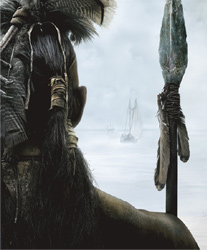Most people come to Greece for one reason - island hopping on the Aegean Sea. One of the easiest and most enjoyable ways to do this is by cruise ship. A variety of boats leave from Athens' port of Piraeus on a regular basis. Some cruises are short and visit only a few islands in three to four days. Others visit more islands over a longer period of time.
Although the ships only stop at each port for several hours, it's usually enough to get a feel for each island and decide at which one you'd like to spend more time on your next visit.Mykonos. Almost every ship docks at Mykonos, one of the most famous and most visited islands. Small enough to walk from one end to the other, the streets are lined with gorgeous white washed houses. Shutters, window and door frames, along with doors and banisters are painted in bright colors, which emphasize the stark whiteness of the houses even more. Blue is the most popular, but green and red are also common.
Mykonos is a beautiful but very crowded island with a very few calm places.In front of a white church with a red domed roof stands Petros the Pelican. The huge bird, perched on the edge of a white wall, cleans himself as tourists timidly approach for a photo.
His pink and blue beak is nearly the size of a man's arm.Near the sandy beach sits a white washed church with a blue dome roof - the epitome of Greece. A white cross crowns the blue dome. Farther along the beach at the top of a gentle hill, a row of windmills form a straight line.
Their base is whitewashed, but the cones topping them are covered in straw. Thin sticks of wood latched together comprise the wheels that spin slowly on the light breeze coming off the sea.Delos. An island close to Mykonos is famous for its ancient temples. Daily excursions can be booked in Mykonos. Delos was the most important Panhellenic sanctuary and, according to mythology, the birth-place of Apollo and Artemis.
The first signs of habitation on the island date from the 3rd millenium B.C. and important remains of the Mycenaean period have been uncovered in the area of the sanctuary. In the 7th century B.C. Delos was already a known Ionic centre because of its religious importance as the birth-place of Apollo.
During the period of the alliance of Grecian kingdoms under Athenian domination, Delos was the designated treasury. Athens, being the capital city and more avaricious than its partners, began to plunder the treasury and used the wealth to build the Acropolis.Santorini.
When you've had just about all the history and white marble you can take, along comes one of Greece's most breathtaking sights, the volcanic island of Santorini. One of nature's most incredible creations, this is the island that everyone plans to revisit. One day here is definitely not enough to absorb the splendor of what has been often referred to as Greece's most beautiful island.
Santorini is considered a caldera - a volcanic depression in the shape of a basin. The caldera was created thousands of years ago when the Strongyli volcano collapsed. Santorini is the portion of the submerged caldera that remains above sea level. The apocalyptic event that resulted in present day Santorini is one of the explanations for the demise of Atlantis, the fabled island kingdom described by Homer and believed to have existed about the time of the volcano's eruption, 12-14,000 years ago.
This, however, is only one of the possible sites of Atlantis, the Canary Islands and the Bahamas being the two most prevalent among the believers in the story.Approaching the crescent shaped island from the deep sea, you may be astounded by its size. The most southern of the Cyclades islands, Santorini looks like a massive, snow capped mountain dropped into the middle of the sea. As you get closer, you'll see that the enormous island isn't covered in snow at all - it's the thick spattering of typically Greek white washed houses that turns its top layer completely white. The sides of the island are too steep to bear any buildings and the majority of the island's structures are built on its flat top.
Numerous cruise ships anchor in the harbor, but the massive island dwarfs even the biggest vessel. Small boats transport tourists from the cruise ship to the shore, where buses wait to drive them up the skinny road that winds its way up the side of the island. Their destination is Oia, a small village set at the edge of the caldera's steep slope.Oia's bars, restaurants and homes sit along the perimeter of the island.
Relaxing at one of the cliffside restaurants provides you with an unbeatable vista of the island and surrounding water. The blue sea glimmers in the bright sun and Santorini stretches on and on. Smaller islands, part of the same volcanic group, are speckled throughout the sea. The east coast of the island boasts the most beautiful beaches, but beware - the black volcanic sand may look spectacular, but it's extra hot on the feet.When it's time to head back to the ship, you have two options.
A set of stairs leads down the rock face to the shore, but taking the cable car is recommended. Not only is it a lot easier, but the final view of the island in its spectacular setting is one you'll savor forever.
.Michael Russell Your Independent guide to Travel.
By: Michael Russell
